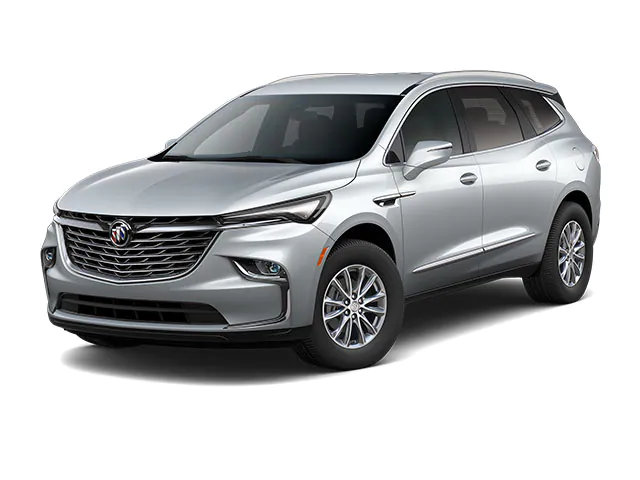Buick Enclave 2022 Seats and Restraints User Manual
A luxurious SUV that sets a high bar for comfort and safety is the Buick Enclave 2022. The sophisticated seating system and restraints, which are created to offer the best comfort and protection for both the driver and passengers, are a key element of its exceptional interior design. The Enclave ensures a comfortable and secure journey for all occupants by placing a strong emphasis on ergonomics, versatility, and safety. A variety of seating arrangements are available at The Enclave to accommodate various requirements and tastes. The Enclave has plenty of space for families or groups of travelers with its standard seating capacity of seven. The first and second rows feature supportive cushions and plenty of legroom to ensure maximum comfort. Drivers and passengers may be able to find their preferred seating position with the touch of a button if the seats have power adjustments. No matter the weather, a comfortable driving experience is guaranteed thanks to the available heated and ventilated seat options.
Head Restraints
Front Seats
Warning
With head restraints that are not installed and adjusted properly, there is a greater chance that occupants will suffer a neck/spinal injury in a crash. Do not drive until the head restraints for all occupants are installed and adjusted properly.
The vehicle’s front seats have adjustable head restraints in the outboard seating positions.

Adjust the head restraint so that the top of the restraint is at the same height as the top of the occupant’s head. This position reduces the chance of a neck injury in a crash.
The height of the head restraint can be adjusted.
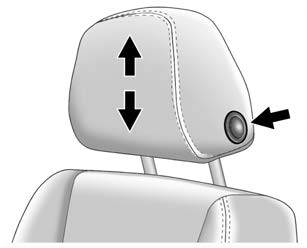
To raise or lower the head restraint, press the button located on the side of the head restraint, and pull up or push the head restraint down, and release the button. Pull and push on the head restraint after the button is released to make sure that it is locked in place.
The front seat outboard head restraints are not removable.
Rear Seats
Second Row Seats
The vehicle’s second row seats have adjustable head restraints in the outboard seating positions.
The height of the head restraint can be adjusted. Pull the head restraint up to raise it. Try to move the head restraint to make sure that it is locked in place.
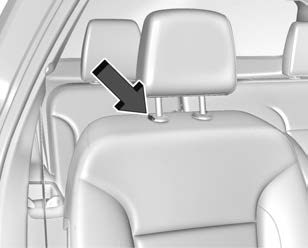
To lower the head restraint, press the button, located on the top of the seatback, and push the head restraint down. Try to move the head restraint after the button is released to make sure that it is locked in place.
Always adjust the head restraint so that the top of the restraint is at the same height as the top of the occupant’s head.
If you are installing a child restraint in the rear seat, see “Securing a Child Restraint Designed for the LATCH System” under Lower Anchors and Tethers for Children
(LATCH System) 0 71.
Third Row Seats
The vehicle’s third row seats have head restraints in the outboard seating positions that cannot be adjusted up or down.
The third row outboard head restraints are not removable.
The third row outboard head restraints are designed to be folded.
The head restraint can be folded to allow for better visibility when the rear seat is unoccupied.
When folding the seatback down, the head restraint will automatically fold out of the way as the seat is folded down.
Return the lowered head restraint to the upright position until it locks into place. Push and pull on the head restraint to make sure it is locked.
The third row outboard head restraints are not removable.
The third row outboard head restraints are designed to be folded.
The head restraint can be folded to allow for better visibility when the rear seat is unoccupied.
When folding the seatback down, the head restraint will automatically fold out of the way as the seat is folded down.
Return the lowered head restraint to the upright position until it locks into place. Push and pull on the head restraint to make sure it is locked.
When an occupant is in the seat, always return the head restraint to the upright position. Pull the head restraint up and push it rearward until it locks into place. Push and pull on the head restraint to make sure that it is locked.
When an occupant is in the seat, always return the head restraint to the upright position. Pull the head restraint up and push it rearward until it locks into place. Push and pull on the head restraint to make sure that it is locked.
Front Seats
Power Seat Adjustment
Warning
You can lose control of the vehicle if you try to adjust a driver seat while the vehicle is moving. Adjust the driver seat only when the vehicle is not moving.
Warning
The power seats will work with the ignition off. Children could operate the power seats and be injured. Never leave children alone in the vehicle.

To adjust the seat:
- Move the seat forward or rearward by sliding the control forward or rearward.
- Raise or lower the front part of the seat cushion by moving the front of the control up or down.
- . Raise or lower the entire seat by moving the rear of the control up or down.
To adjust the seatback, see Reclining Seatbacks page 37.
To adjust the lumbar support, see Lumbar Adjustment page 38.
Reclining Seatbacks
Warning
Sitting in a reclined position when the vehicle is in motion can be dangerous. Even when buckled up, the seat belts cannot do their job.
The shoulder belt will not be against your body. Instead, it will be in front of you. In a crash, you could go into it, receiving neck or other injuries.
The lap belt could go up over your abdomen. The belt forces would be there, not at your pelvic bones. This could cause serious internal injuries.
For proper protection when the vehicle is in motion, have the seatback upright. Then sit well back in the seat and wear the seat belt properly.
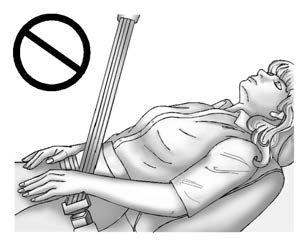
Do not have a seatback reclined if the vehicle is moving.

- Tilt the top of the control rearward to recline.
- Tilt the top of the control forward to raise.
Lumbar Adjustment

Four-Way Shown, Two-Way Similar
To adjust the lumbar support, if equipped:
- Press and hold the front or rear of the control to increase or decrease lumbar
- If equipped, press and hold the top or bottom of the control to raise or lower lumbar support.
Massage
If equipped, the ignition must be on to use the massage feature.
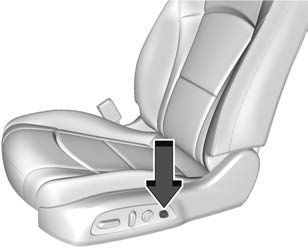
If equipped, press the massage button to use the massage feature. To stop massage, press this button again.
The massage feature will turn off after approximately 10 minutes. Press the massage button to restart the massage feature.
Memory Seats
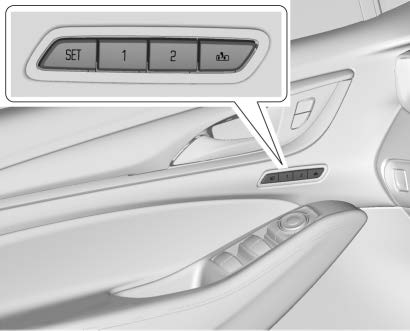
Overview
If equipped, the memory seat feature allows drivers to save their unique driving positions and a shared exit position. See “Saving Seating Positions” later in this section. The saved positions can be recalled manually by all drivers, see “Manually Recalling Seating Positions” later in this section, and drivers with remote key 1 and 2 can also recall them automatically. See “Auto Seat Entry Memory Recall” or “Auto Seat Exit Memory Recall” later in this section. To enable automatic recalls, turn on Seat Entry Memory and/or Seat Exit Memory. See “Enabling Automatic Recalls” later in this section. The memory recalls may be cancelled at any time during the recall. See “Cancel Memory Seating Recalls” later in this section.
Identifying Driver Number
The vehicle identifies the current driver by their remote key number 1–8. The current remote key number may be identified by Driver Information Center (DIC) welcome message, “You are driver x for memory recalls.” This message is displayed the first few times the vehicle is turned on when a different remote key is used. For Seat Entry Memory to work properly, save positions to the 1 or 2 memory button matching the driver number of this welcome message. To aid in identifying remote key IDs, it is recommended to only carry one remote key when entering the vehicle. Perform the following if the welcome message is not displayed:
- Move all keys and remote keys away from the vehicle.
- Start the vehicle with another remote key. A DIC welcome message should display indicating the driver number of the other remote key. Turn the vehicle off and remove the other key or remote key from the vehicle.
- Start the vehicle with the initial key or remote key. The DIC welcome message should display the driver number of the initial remote key.
Saving Seating Positions
Read these instructions completely before saving memory positions.
To save preferred driving positions to 1 and 2:
- Turn the vehicle on or to accessory mode. A DIC welcome message may indicate the driver number of the current remote key. See “Identifying Driver Number” previously in this section.
- Adjust all available memory features to the desired driving position.
- Press and release SET; a beep will sound .
- Immediately upon releasing SET, press and hold memory button 1 or 2 matching the current Driver’s remote key number until two beeps sound. If too much time passes between releasing SET and pressing 1 or 2, the two beeps will not sound indicating memory position were not saved. Repeat Steps 3 and 4 to try again.
- Repeat Steps 1–4 for the other remote key 1 or 2 using the other 1 or 2 memory button .
It is recommended to save the preferred driving positions to both 1 and 2 if you are the only driver.
To save the common exit seating position to B that is used by all drivers for Manually Recalling Seating Positions and Auto Seat Exit Memory Recall features, repeat Steps 1– 4 using B, the exit button.
Manually Recalling Seating Positions
Press and hold 1, 2, or B button until the recall is complete, to recall the positions previously saved to that button.
Manual Memory recall movement for 1, 2 or B buttons may be initiated and will complete to the saved memory position if the vehicle is in or out of P (Park).
Enabling Automatic Recalls
- Seat Entry Memory moves the driver seat to the selected 1 or 2 position when the vehicle is started. Select Settings > Vehicle
- Seating Position > Seat Entry Memory > ON or See “Auto Seat Entry Memory Recall” later in this section.
- Seat Exit Memory moves the driver seat to the preferred exit position of the B button when the vehicle is turned off and the door is opened. Select Settings > Vehicle > Seating Position > Seat Exit Memory > ON or OFF. See “Auto Seat Exit Memory Recall” later in this section.
Auto Seat Entry Memory Recall
Seat Entry Memory will automatically begin movement to the seating positions of the 1 or 2 button corresponding to the driver’s remote key number 1 or 2 detected by the vehicle when:
- The vehicle is turned on.
- Seating positions have been previously saved to the same 1 or 2 button. See “Saving Seating Positions” previously in this section.
- Seat Entry Memory is enabled. See “Enabling Automatic Recalls” previously in this section.
- The vehicle is in P (Park).
Seat Entry Memory Recall will continue if the vehicle is shifted out of P (Park) prior to reaching the saved memory position.
If the saved memory seat position does not automatically recall, verify the recall is enabled. See “Enabling Automatic Recalls” previously in this section.
If the memory seat recalls to the wrong position, the driver’s remote key number 1 or 2 may not match the memory button number positions they were saved to. Try the other remote key or try saving the positions to the other 1 or 2 memory button. See “Saving Seating Positions” previously in this section.
Automatic Seat Entry Memory recalls are only available for driver’s remote key numbers 1 and 2. Remote keys 3–8 will not provide Seat Entry Memory recalls.
Auto Seat Exit Memory Recall
Seat Exit Memory will begin movement to the seating position of the![]() .
.
button when:
The vehicle is turned off and the driver door is open or opened within a short time.
A seating position has been previously been saved to the![]() memory button. See “Saving Seating Positions” previously in this section.
memory button. See “Saving Seating Positions” previously in this section.
- Seat Exit Memory is enabled. See “Enabling Automatic Recalls” previously in this section.
- The vehicle is in P (Park).
Seat Exit Memory recall will continue if the vehicle is shifted out of P (Park) prior to reaching the saved memory position.
Seat Exit Memory is not linked to the driver’s remote key. The seating position saved to B is used for all drivers.
Cancel Memory Seating Recalls
- During any memory recall: Press a power seat control Press SET memory button
- During Manual memory recall:
Release 1, 2, or B memory button
During Auto Seat Entry Memory Recall: Turn vehicle off
Press SET, 1, 2, or B memory buttons
During Auto Seat Exit Memory Recall: Press SET, 1, 2, or B memory buttons
Obstructions
If something has blocked the seat while recalling a memory position, the recall may stop. Remove the obstruction and try the recall again. If the memory position still does not recall, see your dealer.
Heated and Ventilated Front Seats
Warning
If temperature change or pain to the skin cannot be felt, the seat heater may cause burns. To reduce the risk of burns, use care when using the seat heater, especially for long periods of time. Do not place anything on the seat that insulates against heat, such as a blanket, cushion, cover, or similar item. This may cause the seat heater to overheat. An overheated seat heater may cause a burn or may damage the seat.
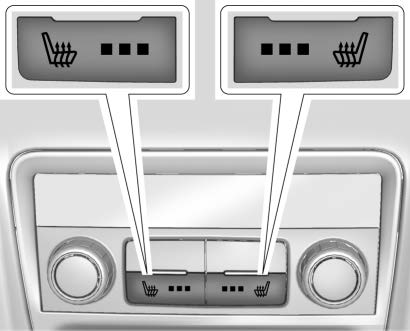
Heated and Ventilated Seat Buttons Shown, Heated Seat Buttons Similar.
If equipped, the buttons are near the climate controls on the center stack. To operate, the engine must be running.
Press ![]() or
or  to heat the driver or passenger seatback and cushion.
to heat the driver or passenger seatback and cushion.
Press ![]() or
or  if available, to ventilate the driver or passenger seat. A ventilated seat has a fan that pulls or pushes air through the seat. The air is not cooled.
if available, to ventilate the driver or passenger seat. A ventilated seat has a fan that pulls or pushes air through the seat. The air is not cooled.
When this feature is off, the heated and ventilated seat symbols on the buttons are white. When a heated seat is turned on, the symbol turns red. When a ventilated seat is turned on, the symbol turns blue.
Press the button once for the highest setting. With each press of the button, the seat will change to the next lower setting, and then to the off setting. The indicator lights next to the buttons indicate three for the highest setting and one for the lowest. If the heated seats are on high, the level may automatically be lowered after approximately 30 minutes.
The passenger seat may take longer to heat up.
Auto Heated and Ventilated Seats
When the vehicle is on, this feature will automatically activate the heated or ventilated seats at the level required by the vehicle’s interior temperature.
The active high, medium, low, or off heated or ventilated seat level will be indicated by the manual heated or ventilated seat buttons on the center stack. Use the manual heated or ventilated seat buttons on the center stack to turn auto heated or ventilated seats off. If the passenger seat is unoccupied, the auto heated or ventilated seats feature will not activate that seat. The
auto heated or ventilated seats feature can be programmed to always be enabled when the vehicle is on.
See Vehicle Personalization page 122.
Remote Start Heated and Ventilated Seats
During a remote start, the heated or ventilated seats, if equipped, can be turned on automatically. When it is cold outside, the heated seats turn on, and when it is hot outside the ventilated seats turn on. The heated or ventilated seats may be canceled when the vehicle is turned on. Press the heated or ventilated seat button to use the heated or ventilated seats after the vehicle is started.
The heated or ventilated seat indicator lights do not turn on during a remote start.
The temperature performance of an unoccupied seat may be reduced. This is normal.
The remote start heated or ventilated seats may be enabled or disabled in the vehicle personalization menu. See Remote Vehicle
Start page 14 and Vehicle Personalization page 122.
Rear Seats
Rear Seat Reminder
If equipped, the message REAR SEAT REMINDER LOOK IN REAR SEAT displays under certain conditions indicating there may be an item or passenger in the rear seat. Check before exiting the vehicle.
This feature will activate when a second row door is opened while the vehicle is on or up to 10 minutes before the vehicle is turned on. There will be an alert when the vehicle is turned off. The alert does not directly detect objects in the rear seat; instead, under certain conditions, it detects when a rear door is opened and closed, indicating that there may be something in the rear seat.
The feature is active only once each time the vehicle is turned on and off, and will require reactivation by opening and closing the second row doors. There may be an alert even when there is nothing in the rear seat; for example, if a child entered the vehicle through the rear door and left the vehicle without the vehicle being shut off.
The feature can be turned on or off. See Vehicle Personalization 0 122.
Rear Seat Adjustment
The second row seats slide forward for more room.

To adjust the seat position:
- Remove objects on the floor in front of or on the second row seat, or in the seat tracks on the floor.
- Lift the lever below the seat cushion and slide the seat forward or backward.
Entering and Exiting the Third Row
Warning
Using the third row seating position while the second row is folded could cause injury in a sudden stop or crash. Be sure to return the seat to the passenger seating position. Push and pull on the seat to make sure it is locked into place.
Warning
If the seatback and seat base are not locked, the seat could move forward in a sudden stop or crash and injure the occupant. Always push and pull on the seatbacks to be sure the seatback and seat base are locked.
Caution
Folding a rear seat with the seat belts still fastened may cause damage to the seat or the seat belts. Always unbuckle the seat belts and return them to their normal stowed position before folding a rear seat.
To access the third row from the passenger side:
The second row passenger side seat can be easily moved for third row entry or exit with a forward-facing child restraint installed using the LATCH system. Remove a rear-facing child restraint before moving the seat for third row entry or exit.
Warning
Remove the child from the child restraint before moving the seat forward for third row entry or exit. Failure to do so may result in injury to the child.
- Remove objects on the floor in front of or under the second row seat, or in the seat tracks on the floor.
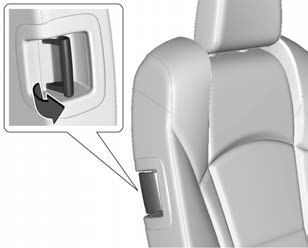
- Pull the handle on the side of the seat forward and pull the seat forward.
Returning the Seat to the Seating Position
To return the second row seat to its normal seating position:+
- Remove objects on the floor behind or under the second row seat or in the seat tracks on the floor.
- Push on the seatback until the seat is locked into place.
- Push and pull on the seatback and seat cushion to make sure they are locked in place .
- Check that the seat belt is not under the seat cushion.
Reclining the Seatbacks
To recline the seatbacks:
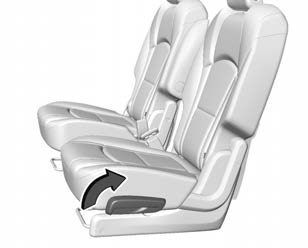
- Leaning rearward in the seat, pull the reclining seatback handle.
- Move the seatback to the desired position, and then release the handle to lock the seatback in place.
- Push and pull on the seatback to make sure it is locked.
Folding the Seatbacks
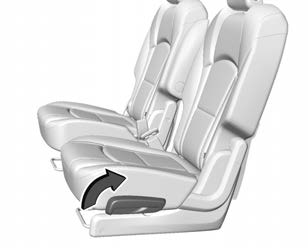
To fold the second row seatbacks:
- Remove anything on or under the seat .
- Pull up on the reclining seatback The seatback will move forward and fold flat on top of the cushion. Do not place anything on the seat during this operation.
To return the seatback to the seating position, lift the seatback and push it rearward until it locks into place. Push and pull on the seatback to make sure it is locked.
Heated Rear Seats
Warning
If temperature change or pain to the skin cannot be felt, the seat heater may cause burns. See the Warning under Heated and Ventilated Front Seats page 41.

If available, the buttons are on the rear of the center console.
With the engine running, press  or
or  to heat the left or right outboard seat cushion. An indicator on the climate control display appears when this feature is on.
to heat the left or right outboard seat cushion. An indicator on the climate control display appears when this feature is on.
This feature turns on at the highest setting. With each press of the button, the heated seat changes to the next lower setting, and then the off setting. Three lights indicate the highest setting, and one light indicates the lowest. If the heated seats are on high, the level may automatically be lowered after approximately 30 minutes.
Third Row Seats
Warning
Using the third row seating position while the second row is folded, or pushed forward in the entry position, could cause injury in a sudden stop or crash. Be sure to return the seat to the passenger seating position. Push and pull on the seat to make sure it is locked into place.
Folding the Seatback
Caution
Folding a rear seat with the seat belts still fastened may cause damage to the seat or the seat belts. Always unbuckle the seat belts and return them to their normal stowed position before folding a rear seat.
To fold the third row seatback:
- Remove objects on the floor in front of or on the second row seat, or in the seat tracks on the floor.
- If the second row seat is in the full rear position, adjust it forward to allow the third row seat to fold fully flat.
- Remove anything on or under the seat.
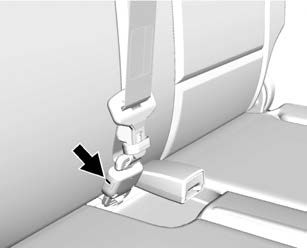
- Disconnect the center seat belt mini-latch, using a key in the slot on the mini-buckle, and let the belt retract into the headliner.

- Stow the mini-latch in the holder in the headliner.
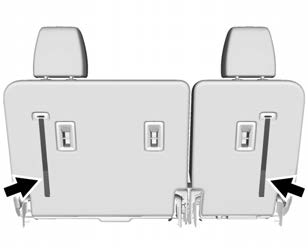
- Pull the release strap located on the seatback.
- Push the seatback forward to lay flat.
- Repeat for the other seatback, if necessary.
Returning the Seat to the Seating Position
To return the seatback to the seating position:
- From the rear of the vehicle, raise the seatback to the upright position using the pull strap on the back of the third row seat, or lift the seatback and push it into place from inside the vehicle.
Warning
If either seatback is not locked, it could move forward in a sudden stop or crash. That could cause injury to the person sitting there. Always push and pull on the seatbacks to be sure they are locked. - Push and pull on the seatback to make sure it is locked in place.
Warning
A seat belt that is improperly routed, not properly attached, or twisted will not provide the protection needed in a crash. The person wearing the belt could be seriously injured. After raising the rear seatback, always check to be sure that the seat belts are properly routed and attached, and are not twisted. - Reconnect the center seat belt mini-latch to the mini-buckle. Do not let it twist.
- Pull on the seat belt to be sure the mini-latch is secure.
Power Seatback Folding
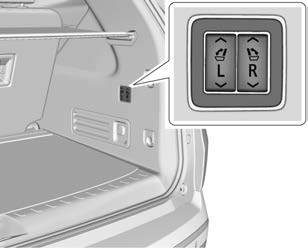
If equipped, the third row seatbacks can also be folded forward and returned to the upright position by pressing and holding the switches on the passenger side of the rear cargo area.
Seat Belts
This section describes how to use seat belts properly, and some things not to do.
Do not let anyone ride where a seat belt cannot be worn properly. In a crash, if you or your passenger(s) are not wearing seat belts, injuries can be much worse than if you are wearing seat belts. You can be seriously injured or killed by hitting things inside the vehicle harder or by being ejected from the vehicle. In addition, anyone who is not buckled up can strike other passengers in the vehicle.
It is extremely dangerous to ride in a cargo area, inside or outside of a vehicle. In a collision, passengers riding in these areas are more likely to be seriously injured or killed. Do not allow passengers to ride in any area of the vehicle that is not equipped with seats and seat belts.
Always wear a seat belt, and check that all passenger(s) are restrained properly too.
This vehicle has indicators as a reminder to buckle the seat belts. See Seat Belt Reminders page 105.
Why Seat Belts Work
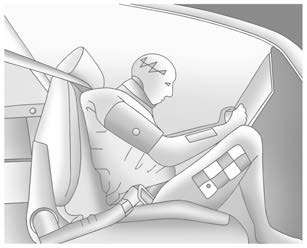
When riding in a vehicle, you travel as fast as the vehicle does. If the vehicle stops suddenly, you keep going until something stops you. It could be the windshield, the instrument panel, or the seat belts!
When you wear a seat belt, you and the vehicle slow down together. There is more time to stop because you stop over a longer distance and, when worn properly, your strongest bones take the forces from the seat belts. That is why wearing seat belts makes such good sense.
Questions and Answers About Seat Belts
Q: Will I be trapped in the vehicle after a crash if I am wearing a seat belt?
A: You could be — whether you are wearing a seat belt or not. Your chance of being conscious during and after a crash, so you can unbuckle and get out, is much greater if you are belted.
Q: If my vehicle has airbags, why should I have to wear seat belts?
A: Airbags are supplemental systems only. They work with seat belts — not instead of them. Whether or not an airbag is provided, all occupants still have to buckle up to get the most protection.
Also, in nearly all states and in all Canadian provinces, the law requires wearing seat belts.
How to Wear Seat Belts Properly
Follow these rules for everyone’s protection.
There are additional things to know about seat belts and children, including smaller children and infants. If a child will be riding in the vehicle, see Older Children page 64 or.
Infants and Young Children page 66. Review and follow the rules for children in addition to the following rules.
It is very important for all occupants to buckle up. Statistics show that unbelted people are hurt more often in crashes than those who are wearing seat belts.
There are important things to know about wearing a seat belt properly.
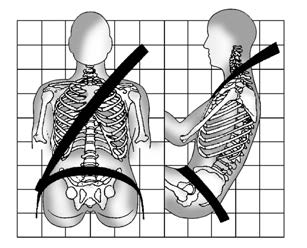
- Sit up straight and always keep your feet on the floor in front of you (if possible).
- Wear the lap part of the belt low and snug on the hips, just touching the thighs. In a crash, this applies force to the strong pelvic bones and you would be less likely to slide under the lap belt.
If you slid under it, the belt would apply force on your abdomen. This could cause serious or even fatal injuries.
- Wear the shoulder belt over the shoulder and across the chest. These parts of the body are best able to take belt restraining forces. The shoulder belt locks if there is a sudden stop or crash.
Warning
You can be seriously injured, or even killed, by not wearing your seat belt properly.

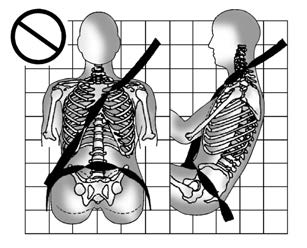
Never allow the lap or shoulder belt to become loose or twisted.

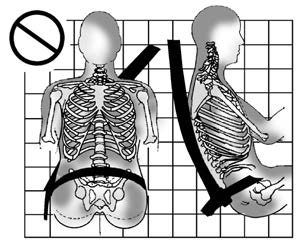
Never wear the shoulder belt under both arms or behind your back.
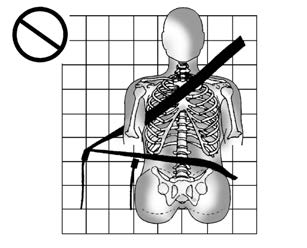
Always use the correct buckle for your seating position.

Never route the lap or shoulder belt over an armrest.
Warning
The seat belt can be pinched if it is routed under plastic trim on the seat, such as trim around the rear seatback folding handle or side airbag. In a crash, pinched seat belts might not provide adequate protection. Never allow seat belts to be routed under plastic trim pieces.
Warning
You can be seriously injured or killed if the shoulder belt is worn behind your back, under your legs, or wrapped around your neck. The shoulder belt can tighten but cannot be loosened if it is locked. The shoulder belt locks when it is pulled all the way out of the retractor. It unlocks when the shoulder belt is allowed to go all the way back into the retractor, but it cannot do this if it is wrapped around you. You may have to cut the seat belt if it is locked and tightened around you.
Lap-Shoulder Belt
All seating positions in the vehicle have a lap-shoulder belt.
If you are using a rear seating position with a detachable seat belt and the seat belt is not attached, see Third Row Seats page 45 for instructions on reconnecting the seat belt to the mini-buckle.
The following instructions explain how to wear a lap-shoulder belt properly.
- Adjust the seat, if the seat is adjustable, so you can sit up straight. To see how, see “Seats” in the Index.
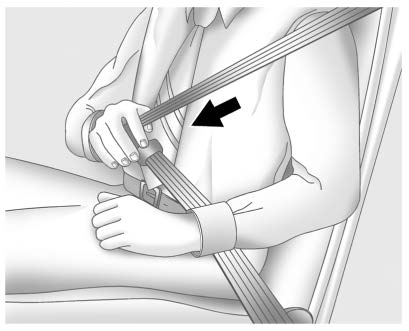
- Pick up the latch plate and pull the belt across you. Do not le t it get twisted.
The lap-shoulder belt may lock if you pull the belt across you very quickly. If this happens, let the belt go back slightly to unlock it. Then pull the belt across you more slowly.
If the shoulder portion of a passenger belt is pulled out all the way, the child restraint locking feature may be engaged. See Child Restraint Systems page 68. If this occurs, let the belt go back all the way and start again. If the locking feature stays engaged after letting the belt go back to stowed position on the seat, move the seat rearward or recline the seat until the shoulder belt retractor lock releases.
Engaging the child restraint locking feature in the front outboard seating position may affect the passenger sensing system. See Passenger Sensing System page 60.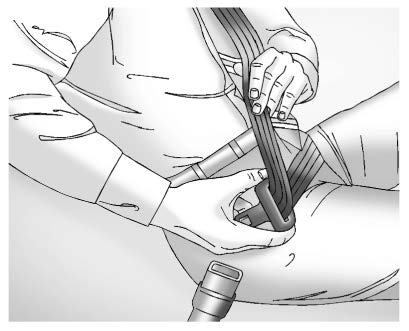
- If the webbing locks in the latch plate before it reaches the buckle, tilt the latch plate flat to unlock.

- Push the latch plate into the buckle until it clicks.
- Pull up on the latch plate to make sure it is secure. If the belt is not long enough, see Seat Belt Extender page 53.
Position the release button on the buckle so that the seat belt could be quickly unbuckled if necessary.
If equipped with a shoulder belt height adjuster, move it to the height that is right for you. See “Shoulder Belt Height Adjuster” later in this section for instructions on use and important safety information.
- To make the lap part tight, pull up on the shoulder belt.
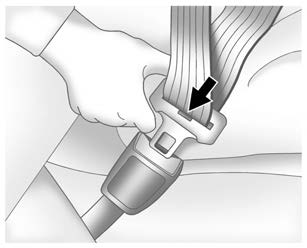
To unlatch the belt, push the button on the buckle. The belt should return to its stowed position.
Always stow the seat belt slowly. If the seat belt webbing returns quickly to the stowed position, the retractor may lock and cannot be pulled out. If this happens, pull the seat belt straight out firmly to unlock the webbing, and then release it. If the webbing is still locked in the retractor, see your dealer.
Before a door is closed, be sure the seat belt is out of the way. If a door is slammed against a seat belt, damage can occur to both the seat belt and the vehicle.
Shoulder Belt Height Adjuster
The vehicle has a shoulder belt height adjuster for the driver and front outboard passenger seating positions.
Adjust the height so that the shoulder portion of the belt is on the shoulder and not falling off of it. The belt should be close to, but not contacting, the neck. Improper shoulder belt height adjustment could reduce the effectiveness of the seat belt in a crash. See How to Wear Seat Belts Properly page 48.
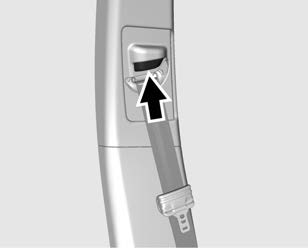
Press and hold the release button while raising or lowering the height adjuster to the desired position.
After the height adjuster is set to the desired position, try to move it down without pressing the release button to make sure it has locked into position.
Seat Belt Pretensioners
This vehicle has seat belt pretensioners for the front outboard occupants. Although the seat belt pretensioners cannot be seen, they are part of the seat belt assembly. They can help tighten the seat belts during the early stages of a moderate to severe frontal, near frontal, or rear crash if the threshold conditions for pretensioner activation are met. Seat belt pretensioners can also help tighten the seat belts in a side crash or a rollover event.
Pretensioners work only once. If the pretensioners activate in a crash, the pretensioners and probably other parts of the vehicle’s seat belt system will need to be replaced. See Replacing Seat Belt System Parts after a Crash page 54.
Do not sit on the outboard seat belt while entering or exiting the vehicle or at any time while sitting in the seat. Sitting on the seat belt can damage the webbing and hardware.
Rear Seat Belt Comfort Guides
Rear seat belt comfort guides may provide added seat belt comfort for older children who have outgrown booster seats and for some adults. When installed on a shoulder belt, the comfort guide positions the shoulder belt away from the neck and head.
Comfort guides are available through your dealer for the rear outboard seating positions. Instructions are included with the guides.
Seat Belt Use During Pregnancy
Seat belts work for everyone, including pregnant women. Like all occupants, they are more likely to be seriously injured if they do not wear seat belts.

A pregnant woman should wear a lap-shoulder belt, and the lap portion should be worn as low as possible, below the rounding, throughout the pregnancy.
The best way to protect the fetus is to protect the mother. When a seat belt is worn properly, it is more likely that the fetus will not be hurt in a crash. For pregnant women, as for anyone, the key to making seat belts effective is wearing them properly.
Seat Belt Extender
If the vehicle’s seat belt will fasten around you, you should use it.
But if a seat belt is not long enough, your dealer will order you an extender. Only a GM dealer issued extender should be used. When you go in to order it, take the heaviest coat you will wear, so the extender will be long enough for you. To help avoid personal injury, do not let someone else use it, and use it only for the seat it is made to fit. The extender has been designed for adults. Never use it for securing child restraints. For more information on the proper use and fit of seat belt extenders see the instruction sheet that comes with the extender.
Safety System Check
Periodically check the seat belt reminder, seat belts, buckles, latch plates, retractors, shoulder belt height adjusters (if equipped), and seat belt anchorages to make sure they are all in working order. Look for any other loose or damaged seat belt system parts that might keep a seat belt system from performing properly. See your dealer to have it repaired. Torn, frayed, or twisted seat belts may not protect you in a crash.
Torn or frayed seat belts can rip apart under impact forces. If a belt is torn or frayed, have it replaced immediately. If a belt is twisted, it may be possible to untwist by reversing the latch plate on the webbing.
If the twist cannot be corrected, ask your dealer to fix it.
Make sure the seat belt reminder light is working. See Seat Belt Reminders page 105.
Keep seat belts clean and dry. See Seat Belt Care page 54.
Seat Belt Care
Keep belts clean and dry.
Seat belts should be properly cared for and maintained.
Seat belt hardware should be kept dry and free of dust or debris. As necessary, exterior hard surfaces and seat belt webbing may be lightly cleaned with mild soap and water. Ensure there is not excessive dust or debris in the mechanism. If dust or debris exists in the system please see the dealer. Parts may need to be replaced to ensure proper functionality of the system.
Warning
Do not bleach or dye seat belt webbing. It may severely weaken the webbing. In a crash, they might not be able to provide adequate protection. Clean and rinse seat belt webbing only with mild soap and lukewarm water. Allow the webbing to dry.
Replacing Seat Belt System Parts after a Crash
Warning
A crash can damage the seat belt system in the vehicle. A damaged seat belt system may not properly protect the person using it, resulting in serious injury or even death in a crash. To help make sure the seat belt systems are working properly after a crash, have them inspected and any necessary replacements made as soon as possible.
After a minor crash, replacement of seat belts may not be necessary. But the seat belt assemblies that were used during any crash may have been stressed or damaged. See your dealer to have the seat belt assemblies inspected or replaced.
New parts and repairs may be necessary even if the seat belt system was not being used at the time of the crash.
Have the seat belt pretensioners checked if the vehicle has been in a crash, or if the airbag readiness light stays on after you start the vehicle or while you are driving. See Airbag Readiness Light page 105.
Airbag System
The vehicle has the following airbags:
- A frontal airbag for the driver
- A frontal airbag for the front outboard passenger
- A front center airbag for the driver and front outboard passenger
- A seat-mounted side impact airbag for the driver
- A seat-mounted side impact airbag for the front outboard passenger
- A roof-rail airbag for the driver and for the second and third row passengers seated directly behind the driver
- A roof-rail airbag for the front outboard passenger and the second and third row passengers seated directly behind the front outboard passenger
All vehicle airbags have the word AIRBAG on the trim or on a label near the deployment opening.
For frontal airbags, the word AIRBAG is on the center of the steering wheel for the driver and on the instrument panel for the front outboard passenger.
For the front center airbag, the word AIRBAG is on the inboard side of the driver seatback.
For seat-mounted side impact airbags, the word AIRBAG is on the side of the seatback or side of the seat closest to the door.
For roof-rail airbags, the word AIRBAG is on the ceiling or trim.
Airbags are designed to supplement the protection provided by seat belts. Even though today’s airbags are also designed to help reduce the risk of injury from the force of an inflating bag, all airbags must inflate very quickly to do their job.
Here are the most important things to know about the airbag system:
Warning
You can be severely injured or killed in a crash if you are not wearing your seat belt, even with airbags. Airbags are designed to work with seat belts, not replace them. Also, airbags are not designed to inflate in every crash. In some crashes seat belts are the only restraint. See When Should an Airbag Inflate? page 57.
Wearing your seat belt during a crash helps reduce your chance of hitting things inside the vehicle or being ejected from it. Airbags are “supplemental restraints” to the seat belts. Everyone in the vehicle should wear a seat belt properly, whether or not there is an airbag for that person.
Because airbags inflate with great force and faster than the blink of an eye, anyone who is up against, or very close to any airbag when it inflates can be seriously injured or killed. Do not sit unnecessarily close to any airbag, as you would be if sitting on the edge of the seat or leaning forward. Seat belts help keep you in position before and during a crash. Always wear a seat belt, even with airbags. The driver should sit as far back as possible while still maintaining control of the vehicle. The seat belts and the front outboard passenger airbags are most effective when you are sitting well back and upright in the seat with both feet on the floor.
Occupants should not lean on or sleep against the front center armrest or console in vehicles with a front center airbag.
Occupants should not lean on or sleep against the door or side windows in seating positions with seat-mounted side impact airbags and/or roof-rail airbags.
Warning
Children who are up against, or very close to, any airbag when it inflates can be seriously injured or killed. Always secure children properly in the vehicle. To read how, see Older Children page 65 or Infants and Young Children page 66.
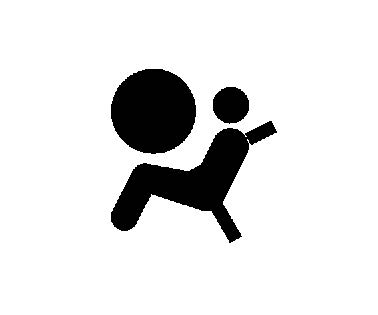
There is an airbag readiness light on the instrument cluster, which shows the airbag symbol.
The system checks the airbag electrical system for malfunctions. The light tells you if there is an electrical problem. See Airbag Readiness Light page 105.
Where Are the Airbags?
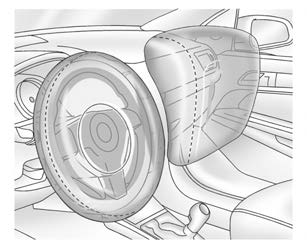
The driver frontal airbag is in the center of the steering wheel.
The front outboard passenger frontal airbag is in the passenger side instrument panel.
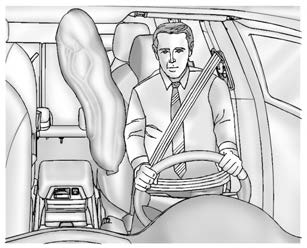
The front center airbag is in the inboard side of the driver seatback.
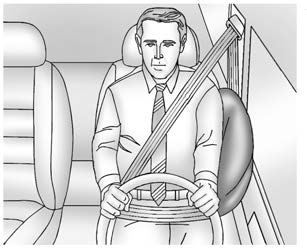
Driver Side Shown, Passenger Side Similar
The driver and front outboard passenger seat-mounted side impact airbags are in the side of the seatbacks closest to the door.
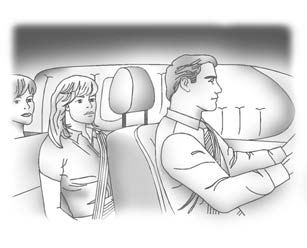
Driver Side Shown, Passenger Side Similar
The roof-rail airbags for the driver, front outboard passenger, and second and third row outboard passengers are in the ceiling above the side windows.
Warning
If something is between an occupant and an airbag, the airbag might not inflate properly or it might force the object into that person causing severe injury or even death. The path of an inflating airbag must be kept clear. Do not put anything between an occupant and an airbag, and do not attach or put anything on the steering wheel hub or on or near any other airbag covering.
Do not use seat or console accessories that block the inflation path of a seat-mounted side impact airbag or the front center airbag.
Never secure anything to the roof of a vehicle with roof-rail airbags by routing a rope or tie-down through any door or window opening. If you do, the path of an inflating roof-rail airbag will be blocked.
When Should an Airbag Inflate?
This vehicle is equipped with airbags. See Airbag System page 54. Airbags are designed to inflate if the impact exceeds the specific airbag system’s deployment threshold.
Deployment thresholds are used to predict how severe a crash is likely to be in time for the airbags to inflate and help restrain the occupants. The vehicle has electronic sensors that help the airbag system.
determine the severity of the impact. Deployment thresholds can vary with specific vehicle design.
Frontal airbags are designed to inflate in moderate to severe frontal crashes to help reduce the potential for severe injuries, mainly to the driver’s or front outboard passenger’s head and chest.
Whether the frontal airbags will or should inflate is not based primarily on how fast the vehicle is traveling. It depends on what is hit, the direction of the impact, and how quickly the vehicle slows down.
Frontal airbags may inflate at different crash speeds depending on whether the vehicle hits an object straight on or at an angle, and whether the object is fixed or moving, rigid or deformable, narrow or wide.
Frontal airbags are not intended to inflate during vehicle rollovers, in rear impacts, or in many side impacts.
In addition, the vehicle has advanced technology frontal airbags. Advanced technology frontal airbags adjust the restraint according to crash severity.
The front center airbag is designed to inflate in moderate to severe side crashes depending upon the location of the impact, when either side of the vehicle is struck. In addition, the front center airbag is designed to inflate when the sensing system predicts that the vehicle is about to roll over on its side. The front center airbag is not designed to inflate in frontal impacts, near frontal impacts, or rear impacts.
Seat-mounted side impact airbags are designed to inflate in moderate to severe side crashes depending on the location of the impact. These airbags may also inflate in some moderate to severe frontal impacts. Seat-mounted side impact airbags are not designed to inflate in rollovers or rear impacts. A seat-mounted side impact airbag is designed to inflate on the side of the vehicle that is struck.
Roof-rail airbags are designed to inflate in moderate to severe side crashes depending on the location of the impact. In addition, these roof-rail airbags may inflate during a rollover or in a severe frontal impact.
Roof-rail airbags are not designed to inflate in rear impacts. Both roof-rail airbags may inflate when either side of the vehicle is struck or if the sensing system predicts that the vehicle is about to roll over on its side, or in a severe frontal impact.
In any particular crash, no one can say whether an airbag should have inflated simply because of the vehicle damage or repair costs.
What Makes an Airbag Inflate?
In a deployment event, the sensing system sends an electrical signal triggering a release of gas from the inflator. Gas from the inflator fills the airbag causing the bag to break out of the cover. The inflator, the airbag, and related hardware are all part of the airbag module.
For airbag locations, see Where Are the Airbags? page 56.
How Does an Airbag Restrain?
In moderate to severe frontal or near frontal collisions, even belted occupants can contact the steering wheel or the instrument panel. In moderate to severe side collisions, even belted occupants can contact the inside of the vehicle.
Airbags supplement the protection provided by seat belts by distributing the force of the impact more evenly over the occupant’s body.
Rollover capable roof-rail airbags are designed to help contain the head and chest of occupants in the outboard seating positions in the first, second, and third rows. The rollover capable roof-rail airbags are designed to help reduce the risk of full or partial ejection in rollover events, although no system can prevent all such ejections.
But airbags would not help in many types of collisions, primarily because the occupant’s motion is not toward those airbags. See When Should an Airbag Inflate? page 57.
Airbags should never be regarded as anything more than a supplement to seat belts.
What Will You See after an Airbag Inflates?
After frontal and seat-mounted side impact airbags inflate, they quickly deflate, so quickly that some people may not even realize the airbags inflated. The front center airbag and roof-rail airbags may still be at least partially inflated for some time after they inflate. Some components of the airbag module may be hot for several minutes. For location of the airbags, see Where Are the Airbags? page 56.
The parts of the airbag that come into contact with you may be warm, but not too hot to touch. There may be some smoke and dust coming from the vents in the deflated airbags. Airbag inflation does not prevent the driver from seeing out of the windshield or being able to steer the vehicle, nor does it prevent people from leaving the vehicle .
Warning
When an airbag inflates, there may be dust in the air. This dust could cause breathing problems for people with a history of asthma or other breathing trouble. To avoid this, everyone in the vehicle should get out as soon as it is safe to do so. If you have breathing problems but cannot get out of the vehicle after an airbag inflates, then get fresh air by opening a window or a door. If you experience breathing problems following an airbag deployment, you should seek medical attention.
airbags inflate. The feature may also activate, without airbag inflation, after an event that exceeds a predetermined threshold. After turning the ignition off and then on again, the fuel system will return to normal operation; the doors can be locked, the interior lamps can be turned off, and the hazard warning flashers can be turned off using the controls for those features.
If any of these systems are damaged in the crash they may not operate as normal.
Warning
A crash severe enough to inflate the airbags may have also damaged important functions in the vehicle, such as the fuel system, brake and steering systems, etc. Even if the vehicle appears to be drivable after a moderate crash, there may be concealed damage that could make it difficult to safely operate the vehicle.
Use caution if you should attempt to restart the engine after a crash has occurred.
In many crashes severe enough to inflate the airbag, windshields are broken by vehicle deformation. Additional windshield breakage may also occur from the front outboard passenger airbag.
Airbags are designed to inflate only After an airbag inflates, you will need some new parts for the airbag system.
After an airbag inflates, you will need some new parts for the airbag system. If you do not get them, the airbag system will not be there to help protect you in another crash. A new system will include airbag modules and possibly other parts. The service manual for the vehicle covers the need to replace other parts.
The vehicle has a crash sensing and diagnostic module which records information after a crash. See Vehicle Data Recording and Privacy page 360 and Event Data Recorders page 361.
- Let only qualified technicians work on the airbag systems. Improper service can mean that an airbag system will not work properly. See your dealer for service.
Passenger Sensing System
The vehicle has a passenger sensing system for the front outboard passenger position. The passenger airbag status indicator will light on the overhead console when the vehicle is started.
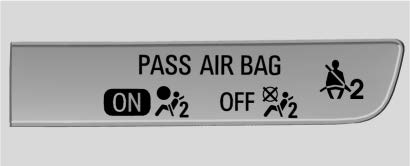
The words ON and OFF, and the symbols for on and off, will be visible during the system check. When the system check is complete, either the word ON or OFF, and the symbol for on or off, will be visible. See Passenger Airbag Status Indicator page 106.
The passenger sensing system turns off the front outboard passenger frontal airbag under certain conditions. No other airbag is affected by the passenger sensing system.
The passenger sensing system works with sensors that are part of the front outboard passenger seat and seat belt. The sensors are designed to detect the presence of a properly seated occupant and determine if the front outboard passenger frontal airbag should be allowed to inflate or not.
According to accident statistics, children are safer when properly secured in a rear seat in the correct child restraint for their weight and size.
Whenever possible, children aged 12 and under should be secured in a rear seating position.
Never put a rear-facing child seat in the front. This is because the risk to the rear-facing child is so great, if the airbag inflates.
Warning
A child in a rear-facing child restraint can be seriously injured or killed if the passenger frontal airbag inflates. This is because the back of the rear-facing child restraint would be very close to the inflating airbag. A child in a forward-facing child restraint can be seriously injured or killed if the passenger frontal airbag inflates and the passenger seat is in a forward position.
Even if the passenger sensing system has turned off the passenger frontal airbag, no system is fail-safe. No one can guarantee that an airbag will not deploy under some unusual circumstance, even though the airbag is turned off.
Never put a rear-facing child restraint in the front seat, even if the airbag is off. If securing a forward-facing child restraint in the front outboard passenger seat, always move the seat as far back as it will go. It is better to secure child restraints in the rear seat. Consider using another vehicle to transport the child when a rear seat is not available.
The passenger sensing system is designed to turn off the front outboard passenger frontal airbag if:
- The front outboard passenger seat is unoccupied.
- The system determines an infant is present in a child restraint.
A front outboard passenger takes his/her weight off of the seat for a period of time.
- There is a critical problem with the airbag system or the passenger sensing
When the passenger sensing system has turned off the front outboard passenger frontal airbag, the OFF indicator will light and stay lit as a reminder that the airbag is off. See Passenger Airbag Status Indicator page 106.
The passenger sensing system is designed to turn on the front outboard passenger frontal airbag anytime the system senses that a person of adult size is sitting properly in the front outboard passenger seat.
When the passenger sensing system has allowed the airbag to be enabled, the ON indicator will light and stay lit as a reminder that the airbag is active.
For some children, including children in child restraints, and for very small adults, the passenger sensing system may or may not turn off the front outboard passenger frontal airbag, depending upon the person’s seating posture and body build. Everyone in the vehicle who has outgrown child restraints should wear a seat belt properly — whether or not there is an airbag for that person.
Warning
If the airbag readiness light ever comes on and stays on, it means that something may be wrong with the airbag system. To help avoid injury to yourself or others, have the vehicle serviced right away. See Airbag Readiness Light page 105 for more information, including important safety information.
If the On Indicator Is Lit for a Child Restraint
The passenger sensing system is designed to turn off the front outboard passenger frontal airbag if the system determines that an infant is present in a child restraint. If a child restraint has been installed and the ON indicator is lit:
- Turn the vehicle off.
- Remove the child restraint from the vehicle.
- Remove any additional items from the seat such as blankets, cushions, seat covers, seat heaters, or seat massagers.
- Reinstall the child restraint following the directions provided by the child restraint manufacturer and refer to Securing Child Restraints (With the Seat Belt in the Rear
Seat) page 79 or Securing Child Restraints (With the Seat Belt in the Front Seat) page 81. - Make sure the seat belt retractor is locked by pulling the shoulder belt all the way out of the retractor when installing the child restraint, even if the child restraint is equipped with a seat belt lock off. When the retractor lock is set, the belt can be tightened but not pulled out of the retractor.
- If, after reinstalling the child restraint and restarting the vehicle, the ON indicator is still lit, turn the vehicle off. Then slightly recline the vehicle seatback and adjust the seat cushion,
- Also make sure the child restraint is not trapped under the vehicle head restraint. If this happens, adjust the head restraint. See Head Restraints page 35.
- Restart the vehicle .
The passenger sensing system may or may not turn off the airbag for a child in a child restraint depending upon the child’s size.
It is better to secure the child restraint in a rear seat. Never put a rear-facing child restraint in the front seat, even if the ON indicator is not lit.
If the Off Indicator Is Lit for an Adult-Sized Occupant
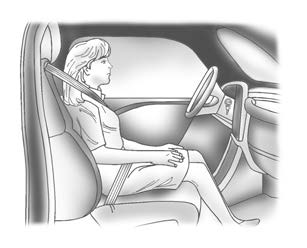
If a person of adult size is sitting in the front outboard passenger seat, but the OFF indicator is lit, it could be because that person is not sitting properly in the seat or that the child restraint locking feature is engaged. Use the following steps to allow the system to detect that person and enable the front outboard passenger frontal airbag:
- Turn the vehicle off.
- Remove any additional material from the seat, such as blankets, cushions, seat covers, seat heaters, or seat massagers.
- Place the seatback in the fully upright.
- Have the person sit upright in the seat, centered on the seat cushion, with legs comfortably extended.
- If the shoulder portion of the belt is pulled out all the way, the child restraint locking feature will be engaged. This may unintentionally cause the passenger sensing system to turn the airbag off for some adult-sized occupants. If this happens, unbuckle the belt, let the belt go back all the way, and then buckle the belt again without pulling the belt out all the way.
- Restart the vehicle and have the person remain in this position for two to three minutes after the ON indicator is lit.
Warning
If the front outboard passenger airbag is turned off for an adult-sized occupant, the airbag will not be able to inflate and help protect that person in a crash, resulting in an increased risk of serious injury or even death. An adult-sized occupant should not ride in the front outboard passenger seat, if the passenger airbag OFF indicator is lit.
Additional Factors Affecting System Operation
Seat belts help keep the passenger in position on the seat during vehicle maneuvers and braking, which helps the passenger sensing system maintain the passenger airbag status. See “Seat Belts” and “Child Restraints” in the Index for additional information about the importance of proper restraint use.
A thick layer of additional material, such as a blanket or cushion, or aftermarket equipment such as seat covers, seat heaters, and seat massagers can affect how well the passenger sensing system operates. We recommend that you not use seat covers or other aftermarket equipment except when approved by GM for your specific vehicle. See Adding Equipment to the Airbag-Equipped Vehicle 0 63 for more information about modifications that can affect how the system operates.
The ON indicator may be lit if an object, such as a briefcase, handbag, grocery bag, laptop, or other electronic device, is put on an unoccupied seat. If this is not desired, remove the object from the seat .
Warning
Stowing articles under the passenger seat or between the passenger seat cushion and seatback may interfere with the proper operation of the passenger sensing system.
Servicing the Airbag-Equipped Vehicle
Airbags affect how the vehicle should be serviced. There are parts of the airbag system in several places around the vehicle. Your dealer and the service manual have information about servicing the vehicle and the airbag system. To purchase a service manual, see Publication Ordering Information page 358.
Warning
For up to 10 seconds after the vehicle is turned off and the battery is disconnected, an airbag can still inflate during improper service. You can be injured if you are close to an airbag when it inflates. Avoid yellow connectors. They are probably part of the airbag system. Be sure to follow proper service procedures, and make sure the person performing work for you is qualified to do so.
Adding Equipment to the Airbag-Equipped Vehicle
Adding accessories that change the vehicle’s frame, bumper system, height, front end, or side sheet metal may keep the airbag system from working properly.
The operation of the airbag system can also be affected by changing, including improperly repairing or replacing, any parts of the following:
- Airbag system, including airbag modules, front or side impact sensors, sensing and diagnostic module, airbag wiring, or front center console
- Front seats, including stitching, seams or zippers
- Seat belts
- Steering wheel, instrument panel, overhead console, ceiling trim, or pillar garnish trim
- Inner door seals, including speakers
- Your dealer and the service manual have information about the location of the airbag modules and sensors, sensing and diagnostic module, and airbag wiring along with the proper replacement procedures In addition, the vehicle has a passenger sensing system for the front outboard passenger position, which includes sensors that are part of the passenger’s seat. The passenger sensing system may not operate properly if the original seat trim is replaced with non-GM covers, upholstery, or trim, or with GM covers, upholstery, or trim designed for a different vehicle. Any object, such as an aftermarket seat heater or a comfort enhancing pad or device, installed under or on top of the seat fabric, could also interfere with the operation of the passenger sensing system. This could either prevent proper deployment of the passenger airbag(s) or prevent the passenger sensing system from properly turning off the passenger airbag(s). See Passenger Sensing System page 60. If the vehicle has rollover roof-rail airbags, see Different Size Tires and Wheels pag311 for additional important information. If the vehicle must be modified because you have a disability and you have questions about whether the modifications will affect the vehicle’s airbag system, or if you have questions about whether the airbag system will be affected if the vehicle is modified for any other reason, call Customer Assistance. See Customer Assistance Offices page 353.Airbag System Check
The airbag system does not need regularly scheduled maintenance or replacement. Make sure the airbag readiness light is working. See Airbag Readiness Light page 105.
Caution
If an airbag covering is damaged, opened, or broken, the airbag may not work properly. Do not open or break the airbag coverings. If there are any opened or broken airbag coverings, have the airbag covering and/or airbag module replaced. For the location of the airbags, see Where Are the Airbags? page 56. See your dealer for service.
Replacing Airbag System Parts after a Crash
Warning
A crash can damage the airbag systems in the vehicle. A damaged airbag system may not properly protect you and your passenger(s) in a crash, resulting in serious injury or even death. To help make sure the airbag systems are working properly after a crash, have them inspected and any necessary replacements made as soon as possible.
If an airbag inflates, you will need to replace airbag system parts. See your dealer for service
If the airbag readiness light stays on after the vehicle is started or comes on when you are driving, the airbag system may not work properly. Have the vehicle serviced right away. See Airbag Readiness Light page 105.
Child Restraints
Older Children
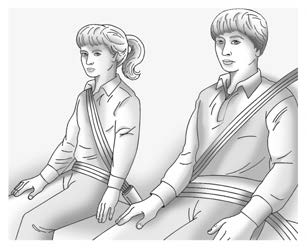
Older children who have outgrown booster seats should wear the vehicle’s seat belts.
The manufacturer instructions that come with the booster seat state the weight and height limitations for that booster. Use a booster seat with a lap-shoulder belt until the child passes the fit test below:
- Sit all the way back on the seat. Do the knees bend at the seat edge? If yes, continue. If no, return to the booster seat.
- Buckle the lap-shoulder belt. Does the shoulder belt rest on the shoulder? If yes, continue. If no, try using the rear seat belt comfort guide, if See “Rear Seat Belt Comfort Guides” under Lap-Shoulder Belt page 50. If a comfort guide is not available, or if the shoulder belt still does not rest on the shoulder, then return to the booster seat.
- Does the lap belt fit low and snug on the hips, touching the thighs? If yes, If no, return to the booster seat.
- Can proper seat belt fit be maintained for the length of the trip? If yes, continue.
If no, return to the booster seat.
Q: What is the proper way to wear seat belts?
A: An older child should wear a lap-shoulder belt and get the additional restraint a shoulder belt can provide. The shoulder belt should not cross the face or neck.
The lap belt should fit snugly below the hips, just touching the top of the thighs. This applies belt force to the child’s pelvic bones in a crash. It should never be worn over the abdomen, which could cause severe or even fatal internal injuries in a crash.
Also see “Rear Seat Belt Comfort Guides” under Lap-Shoulder Belt page 50.
According to accident statistics, children are safer when properly restrained in a rear seating position.
In a crash, children who are not buckled up can strike other people who are buckled up, or can be thrown out of the vehicle. Older children need to use seat belts properly.
Warning
Never allow more than one child to wear the same seat belt. The seat belt cannot properly spread the impact forces. In a crash, they can be crushed together and seriously injured. A seat belt must be used by only one person at a time.
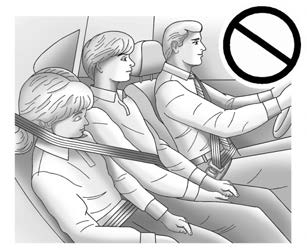
Warning
Never allow a child to wear the seat belt shoulder belt under both arms or behind their back. A child can be seriously injured by not wearing the lap-shoulder belt properly. In a crash, the child would not be restrained by the shoulder belt. The child could move too far forward increasing the chance of head and neck injury. The child might also slide under the lap belt. The belt force would then be applied right on the abdomen. That could cause serious or fatal injuries. The shoulder belt should go over the shoulder and across the chest.
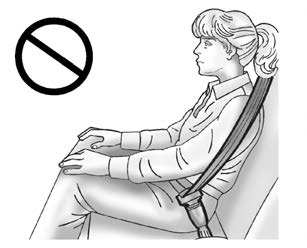
Infants and Young Children
Everyone in a vehicle needs protection! This includes infants and all other children.
Neither the distance traveled nor the age and size of the traveler changes the need, for everyone, to use safety restraints. In fact, the law in every state in the United States and in every Canadian province says children up to some age must be restrained while in a vehicle .
Warning
Children can be seriously injured or killed if the shoulder belt is worn behind their back, under their legs, or wrapped around their neck. The shoulder belt can tighten but cannot be loosened if it is locked. The shoulder belt locks when it is pulled all the way out of the retractor. It unlocks when the shoulder belt is allowed to go all the way back into the retractor, but it cannot do this if it is wrapped around the child. Never leave children unattended in a vehicle and never allow children to improperly wear, or play with, the seat belts.
their neck. The shoulder belt can tighten but cannot be loosened if it is locked. The shoulder belt locks when it is pulled all the way out of the retractor. It unlocks when the shoulder belt is allowed to go all the way back into the retractor, but it cannot do this if it is wrapped around the child. Never leave children unattended in a vehicle and never allow children to improperly wear, or play with, the seat belts.
Every time infants and young children ride in vehicles, they should have the protection provided by appropriate child restraints.
Neither the vehicle’s seat belt system nor its airbag system is designed for them.
Children who are not restrained properly can strike other people, or can be thrown out of the vehicle.
Warning
Never hold an infant or a child while riding in a vehicle. Due to crash forces, an infant or a child will become so heavy it is not possible to hold it during a crash. For example, in a crash at only
40 km/h (25 mph), a 5.5 kg (12 lb) infant will suddenly become a 110 kg (240 lb) force on a person’s arms. An infant or child should be secured in an appropriate child restraint.
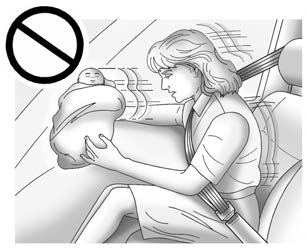
Warning
Never allow a child to wear the seat belt shoulder belt under both arms or behind their back. A child can be seriously injured by not wearing the lap-shoulder belt properly. In a crash, the child would not be restrained by the shoulder belt. The child could move too far forward increasing the chance of head and neck injury. The child might also slide under the lap belt. The belt force would then be applied right on the abdomen. That could cause serious or fatal injuries. The shoulder belt should go over the shoulder and across the chest.
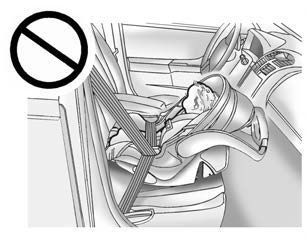
Child restraints are devices used to restrain, seat, or position children in the vehicle and are sometimes called child seats or car seats.
There are three basic types of child restraints:
- Forward-facing child restraints
- Rear-facing child restraints
- Belt-positioning booster seats
The proper child restraint for your child depends on their size, weight, and age, and also on whether the child restraint is compatible with the vehicle in which it will be used.
For each type of child restraint, there are many different models available. When purchasing a child restraint, be sure it is designed to be used in a motor vehicle and is designed by a genuine child restraint manufacturer. If it is, the child restraint will have a label saying that it meets federal motor vehicle safety standards.
The instruction manual that is provided with the child restraint states the weight and height limitations for that particular child restraint. In addition, there are many kinds of child restraints available for children with special needs .
Warning
To reduce the risk of neck and head injury in a crash, infants and toddlers should be secured in a rear-facing child restraint until age two, or until they reach the maximum height and weight limits of their child restraint.
A young child’s hip bones are still so small that the vehicle seat belt may not remain low on the hip bones, as it should. Instead, it may settle up around the child’s abdomen. In a crash, the belt would apply force on a body area that is unprotected by any bony structure. This alone could cause serious or fatal injuries. To reduce the risk of serious or fatal injuries during a crash, young children should always be secured in an appropriate child restraint.
Child Restraint Systems
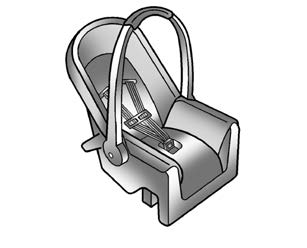
Rear-Facing Infant Restraint
A rear-facing child restraint provides restraint with the seating surface against the back of the infant.
The harness system holds the infant in place and, in a crash, acts to keep the infant positioned in the restraint.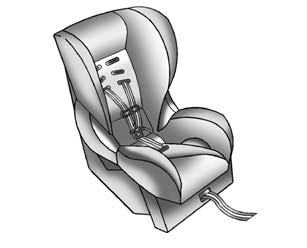
Forward-Facing Child Restraint
A forward-facing child restraint provides restraint for the child’s body with the harness.
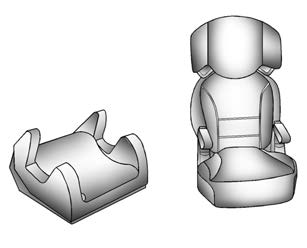
Booster Seats
A belt-positioning booster seat is used for children who have outgrown their forward-facing child restraint. Boosters are designed to improve the fit of the vehicle’s seat belt system until the child is large enough for the vehicle seat belts to fit properly without a booster seat. See the seat belt fit test in Older Children page 64.
Securing an Add-On Child Restraint in the Vehicle
Warning
A child can be seriously injured or killed in a crash if the child restraint is not properly secured in the vehicle. Secure the child restraint properly in the vehicle using the vehicle seat belt or LATCH system, following the instructions that came with that child restraint and the instructions in this manual.
To help reduce the chance of injury, the child restraint must be secured in the vehicle. Child restraints must be secured in vehicle seats by lap belts or the lap belt portion of a lap-shoulder belt, or by the LATCH system. See Lower Anchors and Tethers for Children (LATCH System) page 71 for more information. Never use a seat belt extender when installing a child restraint. Never use non-regulated aftermarket anchors or attachments to secure a child restraint. Children can be endangered in a crash if the child restraint is not properly secured in the vehicle.
When securing an add-on child restraint, refer to the following:
- Instruction labels provided on the child restraint
- Instruction manual provided with the child restraint
- This vehicle owner’s manual
The child restraint instructions are important, so if they are not available, obtain a replacement copy from the manufacturer.
Keep in mind that an unsecured child restraint can move around in a collision or sudden stop and injure people in the vehicle. Be sure to properly secure any child restraint in the vehicle — even when no child is in it.
In some areas Certified Child Passenger Safety Technicians (CPSTs) are available to inspect and demonstrate how to correctly use and install child restraints. In the U.S., refer to the National Highway Traffic Safety Administration (NHTSA) website to locate the nearest child safety seat inspection station. For CPST availability in Canada, check with Transport Canada or the Provincial Ministry of Transportation office.
Securing the Child Within the Child Restraint
Warning
A child can be seriously injured or killed in a crash if the child is not properly secured in the child restraint. Secure the child properly following the instructions that came with that child restraint.
Where to Put the Restraint
According to accident statistics, children and infants are safer when properly restrained in an appropriate child restraint secured in a rear seating position.
Whenever possible, children aged 12 and under should be secured in a rear seating position.
The vehicle is equipped with a front center airbag in the inboard side of the driver seat. Even with a front center airbag, a child restraint can be installed in any second row seating position.
Never put a rear-facing child restraint in the front. This is because the risk to the rear-facing child is so great if the airbag deploys.
Warning
A child in a rear-facing child restraint can be seriously injured or killed if the front passenger airbag inflates. This is because the back of the rear-facing child restraint would be very close to the inflating airbag. A child in a forward-facing child restraint can be seriously injured or killed if the front passenger airbag inflates and the passenger seat is in a forward position.
Even if the passenger sensing system has turned off the front passenger frontal airbag, no system is fail-safe. No one can guarantee that an airbag will not deploy under some unusual circumstance, even though it is turned off.
Secure rear-facing child restraints in a rear seat, even if the airbag is off. If you secure a forward-facing child restraint in the front seat, always move the front passenger seat as far back as it will go. It is better to secure the child restraint in a rear seat.
See Passenger Sensing System page 60 for additional information.
If a child restraint is installed in a second row center seat, move the second row seat to the rearward position, whenever possible, to minimize contact with the front center airbag.
When securing a child restraint with the seat belts in a rear seat position, study the instructions that came with the child restraint to make sure it is compatible with this vehicle.
Child restraints and booster seats vary considerably in size, and some may fit in certain seating positions better than others. Do not install a child restraint in any rear seating position where it cannot be installed securely.
Depending on where you place the child restraint and the size of the child restraint, you may not be able to access adjacent seat belts or LATCH anchors for additional passengers or child restraints. Adjacent seating positions should not be used if the child restraint prevents access to or interferes with the routing of the seat belt.
The seat in front of an installed child restraint should be adjusted to ensure proper installation according to the child restraint manual.
When installing a child restraint in an adjustable second row seating position, the seat should be adjusted fore or aft to ensure proper installation according to the child restraint manual. If the seat is able to recline, the seat back should be positioned to its full upright position before installing a child restraint.
Wherever a child restraint is installed, be sure to follow the instructions that came with the child restraint and secure the child restraint properly.
Keep in mind that an unsecured child restraint can move around in a collision or sudden stop and injure people in the vehicle. Be sure to properly secure any child restraint in the vehicle — even when no child is in it.
Lower Anchors and Tethers for Children (LATCH System)
The LATCH system secures a child restraint during driving or in a crash. LATCH attachments on the child restraint are used to attach the child restraint to the anchors in the vehicle. This system is designed to make installation of a child restraint easier.
In order to use the LATCH system in your vehicle, you need a child restraint that has LATCH attachments. LATCH-compatible rear-facing and forward-facing child seats can be properly installed using either the LATCH anchors or the vehicle’s seat belts. Do not use both the seat belts and the LATCH anchorage system to secure a rear-facing or forward-facing child restraint.
Booster seats use the vehicle’s seat belts to secure the child and the booster seat. If the manufacturer recommends that the booster seat be secured with the LATCH system, this can be done as long as the booster seat can be positioned properly and there is no interference with the proper positioning of the lap-shoulder belt on the child.
Make sure to follow the instructions that came with the child restraint, and also the instructions in this manual.
When installing a child restraint with a top tether, you must also use either the lower anchors or the seat belts to properly secure the child restraint. A child restraint must never be attached using only the top tether.
For a forward-facing 5-pt harness child restraint where the combined weight of the child and restraint are up to 29.5 kg (65 lb), use either the lower LATCH anchorages with the top tether anchorage, or the seat belt with the top tether anchorage. Where the combined weight of the child and restraint are greater than 29.5 kg (65 lb), use the seat belt with the top tether anchorage only.
Recommended Methods for Attaching Child Restraints
| Restraint Type | Combined Weight of the Child + Child Restraint | Use Only Approved Attachment Methods Shown with an X | |||
| LATCH – Lower Anchors Only | Seat Belt Only | LATCH – Lower Anchors and Top Tether Anchor | Seat Belt and Top Tether Anchor | ||
| Rear-Facing Child Restraint | Up to 29.5 kg (65 lb) | X | X | ||
| Rear-Facing Child Restraint | Greater than29.5 kg (65 lb) | X | |||
| Forward-Facing Child Restraint | Up to 29.5 kg (65 lb) | X | X | ||
| Forward-Facing Child Restraint | Greater than29.5 kg (65 lb) | X | |||
See Securing Child Restraints (With the Seat Belt in the Rear Seat) page 79 or Securing Child Restraints (With the Seat Belt in the Front Seat) page 81.
Child restraints built after March 2014 are labeled with the maximum child weight, with which the LATCH system can be used for installing the child restraint.
The following explains how to attach a child restraint with these attachments in the vehicle.
Not all vehicle seating positions have lower anchors. In this case, the seat belt must be used (with top tether where available) to secure the child restraint. See Securing Child Restraints (With the Seat Belt in the Rear Seat) page 79 or Securing Child Restraints (With the Seat Belt in the Front Seat) page 81.
Lower Anchors
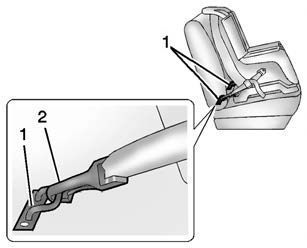
Lower anchors (1) are metal bars built into the vehicle. There are two lower anchors for each LATCH seating position that will accommodate a child restraint with lower attachments (2).
Top Tether Anchor

A top tether (3, 4) is used to secure the top of the child restraint to the vehicle. A top tether anchor is built into the vehicle. The top tether attachment hook (2) on the child restraint connects to the top tether anchor in the vehicle in order to reduce the forward movement and rotation of the child restraint during driving or in the event of a crash.
The child restraint may have a single tether (3) or a dual tether (4). Either will have a single attachment hook (2) to secure the top tether to the anchor.
Some child restraints with a top tether are designed for use with or without the top tether being attached. Others require top tether always to be attached. In Canada, the law requires that forward-facing child restraints have a top tether, and that the tether be attached. Be sure to read and follow the instructions for your child restraint
Lower Anchor and Top Tether Anchor Locations

Second Row
Seating positions with top tether anchors.
Seating positions with two lower anchors.
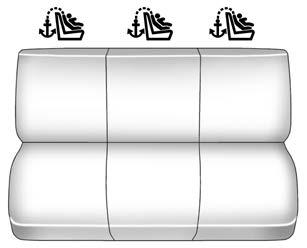
Third Row
Seating positions with top tether anchors.

To assist in locating the lower anchors, each seating position with lower anchors has two labels with the lower anchor symbol on them, near the crease between the seatback and the seat cushion.
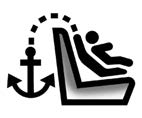
To assist in locating the top tether anchors, the top tether anchor symbol is near the anchor.

Second Row
The top tether anchors are on the rear of the seatback for each seating position in the second row.
Be sure to use an anchor located directly behind the seating position where the child restraint will be placed.
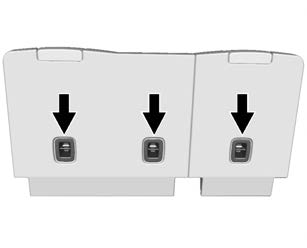
Third Row
The top tether anchors are on the rear of the seatback for each seating position in the third row.
For models with a cargo cover, the top tether anchors are on the back of the rear seatbacks. Remove the cargo cover before installing the top tether. The cargo cover should remain off while the top tether is in use. Be sure to use an anchor directly behind the seating position where the child restraint will be placed.
Do not secure a child restraint in a position without a top tether anchor if a national or local law requires that the top tether be attached, or if the instructions that come with the child restraint say that the top tether must be attached.
According to accident statistics, children and infants are safer when properly restrained in a child restraint system or infant restraint system secured in a rear seating position. See Where to Put the Restraint page 70 for additional information.
Securing a Child Restraint Designed for the LATCH System
Warning
A child could be seriously injured or killed in a crash if the child restraint is not properly attached to the vehicle using either the LATCH anchors or the vehicle seat belt. Follow the instructions that came with the child restraint and the instructions in this manual.
To reduce the risk of serious or fatal injuries during a crash, do not attach more than one child restraint to a single anchor. Attaching more than one child restraint to a single anchor could cause the anchor or attachment to come loose or even break during a crash. A child or others could be injured.
Warning
Children can be seriously injured or strangled if a shoulder belt is wrapped around their neck. The shoulder belt can tighten but cannot be loosened if it is locked. The shoulder belt locks when it is pulled all the way out of the retractor. It unlocks when the shoulder belt is allowed to go all the way back into the retractor, but it cannot do this if it is wrapped around a child’s neck. If the shoulder belt is locked and tightened around a child’s neck, the only way to loosen the belt is to cut it.
Buckle any unused seat belts behind the child restraint so children cannot reach them. Pull the shoulder belt all the way out of the retractor to set the lock, and tighten the belt behind the child restraint after the child restraint has been installed.
Caution
Do not let the LATCH attachments rub against the vehicle’s seat belts. This may damage these parts. If necessary, move buckled seat belts to avoid rubbing the LATCH attachments.
Do not fold the rear seatback when the seat is occupied. Do not fold the empty rear seat with a seat belt buckled. This could damage the seat belt or the seat. Unbuckle and return the seat belt to its stowed position, before folding the seat.
This vehicle is equipped with a front center airbag in the inboard side of the driver seat. Even with a front center airbag, a child restraint can be installed in any second row seating position. If a child restraint is installed in a second row center seat, move the second row seat to the rearward position, whenever possible, to minimize contact with the front center airbag
If you need to secure more than one child restraint in the rear seat, see Where to Put the Restraint page 70.
- Put the child restraint on the seat.
- Attach and tighten the lower attachments to the lower anchors. If the child restraint does not have lower attachments or the desired seating position does not have lower anchors, secure the child restraint with the top tether and the seat belt. Refer to your child restraint manufacturer instructions and the instructions in this manual.
- Find the lower anchors for the desired seating position.
- To access the lower anchors in the second row, it may help to recline the seatback.
Third row seatbacks must be upright before placing the child restraint on the seat. - Put the child restraint on the seat.
- Attach and tighten the lower attachments on the child restraint to the lower anchors.
If necessary, adjust the angle of the second row seatback to achieve a tight installation. Make sure the second row bench seatbacks are aligned at the same angle.
- If the child restraint manufacturer recommends that the top tether be attached, adjust the top tether to its full length and attach it to the anchor. Refer to the child restraint instructions and the following steps:
- Find the top tether anchor.
- Route, attach, and tighten the top tether according to your child restraint instructions and the following instructions:
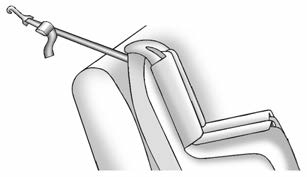 If the position you are using does not have a head restraint and you are using a single tether, route the tether over the seatback.
If the position you are using does not have a head restraint and you are using a single tether, route the tether over the seatback.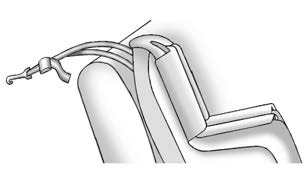 If the position you are using does not have a head restraint and you are using a dual tether, route the tether over the seatback.
If the position you are using does not have a head restraint and you are using a dual tether, route the tether over the seatback.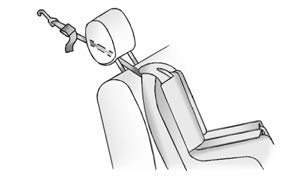 If the position you are using has an adjustable headrest or head restraint, adjust it accordingly to allow proper fitment. If you are using a single tether, route the tether in between the headrest or head restraint posts.
If the position you are using has an adjustable headrest or head restraint, adjust it accordingly to allow proper fitment. If you are using a single tether, route the tether in between the headrest or head restraint posts.
If the position you are using has an adjustable headrest or head restraint, adjust it accordingly to allow proper fitment. If you are using a dual tether, route the tether around the headrest or head restraint posts. If the child restraint is installed next to a center seat, make sure the top tether does not interfere with the center seating position shoulder belt/retractor. If it does, find another suitable seating position to install the child restraint.
If the child restraint is installed next to a center seat, make sure the top tether does not interfere with the center seating position shoulder belt/retractor. If it does, find another suitable seating position to install the child restraint. If the position you are using has a fixed head restraint and you are using a single tether, route the tether under the head restraint and in between the head restraint posts or around the outboard side of the head restraint.
If the position you are using has a fixed head restraint and you are using a single tether, route the tether under the head restraint and in between the head restraint posts or around the outboard side of the head restraint.
If the position you are using has a fixed head restraint and you are using a dual tether, route the tether around the head restraint.
If the child restraint is installed next to a center seat, make sure the top tether does not interfere with the center seating position shoulder belt/retractor. If it does, find another suitable seating position to install the child restraint.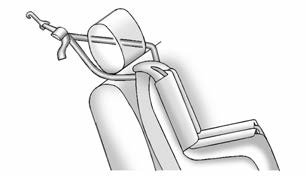
- Before placing a child in the child restraint, make sure it is securely held in place. To check, grasp the child restraint at the LATCH path and attempt to move it side to side and back and forth. There should be no more than 2.5 cm (1 in) of movement, for proper installation.
Head Restraint Removal and Reinstallation
The second row outboard head restraints can be removed if they interfere with the proper installation of the child restraint.
The third row head restraints cannot be removed.
To remove the head restraint:
- Partially fold the seatback forward. See Rear Seats page 43 for additional information.
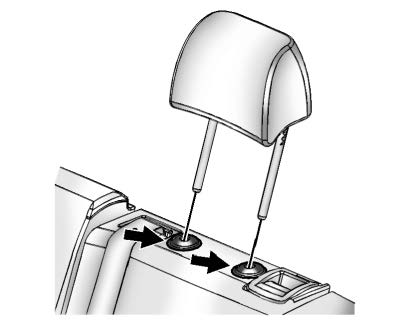
- Press both buttons on the head restraint posts at the same time, and pull up on the head restraint.
- Store the head restraint in the cargo area of the vehicle.
- When the child restraint is removed, reinstall the head restraint before the seating position is used.
Warning
With head restraints that are not installed and adjusted properly, there is a greater chance that occupants will suffer a neck/spinal injury in a crash. Do not drive until the head restraints for all occupants are installed and adjusted properly.
To reinstall the head restraint:
- Insert the head restraint posts into the holes in the top of the seatback. The notches on the posts must face the driver side of the vehicle.
- Push the head restraint down.
- Try to move the head restraint to make sure that it is locked in place.
- Replacing LATCH System Parts After a Crash
Warning
A crash can damage the LATCH system in the vehicle. A damaged LATCH system may not properly secure the child restraint, resulting in serious injury or even death in a crash. To help make sure the LATCH system is working properly after a crash, see your dealer to have the system inspected and any necessary replacements made as soon as possible.
If the vehicle has the LATCH system and it was being used during a crash, new LATCH system parts may be needed.
New parts and repairs may be necessary even if the LATCH system was not being used at the time of the crash.
Securing Child Restraints (With the Seat Belt in the Rear Seat)
The vehicle is equipped with a front center airbag in the inboard side of the driver seat. Even with a front center airbag, a child restraint can be installed in any second row seating position. If you install a child restraint in a second row center seat, move the second row seat to the rearward position, whenever possible, to minimize contact with the front center airbag.
When securing a child restraint with the seat belts in a rear seat position, study the instructions that came with the child restraint to make sure it is compatible with this vehicle.
If the child restraint has the LATCH system, see Lower Anchors and Tethers for Children (LATCH System) page 71 for how and where to install the child restraint using LATCH. If a child restraint is secured in the vehicle using a seat belt and it uses a top tether, see Lower Anchors and Tethers for Children (LATCH System) page 71 for top tether anchor locations.
Do not secure a child seat in a position without a top tether anchor if a national or local law requires that the top tether be anchored, or if the instructions that come with the child restraint say that the top tether must be anchored.
In Canada, the law requires that forward-facing child restraints have a top tether, and that the tether be attached.
If the child restraint or vehicle seat position does not have the LATCH system, you will be using the seat belt to secure the child restraint. Be sure to follow the instructions that came with the child restraint.
If more than one child restraint needs to be installed in the rear seat, be sure to read Where to Put the Restraint page 70.
- Put the child restraint on the seat.
- Pick up the latch plate and run the lap and shoulder portions of the vehicle seat belt through or around the child Ensure the seat belt webbing is routed as directly as possible and is not caught on seat handles or plastic trim. The child restraint instructions will show you how.
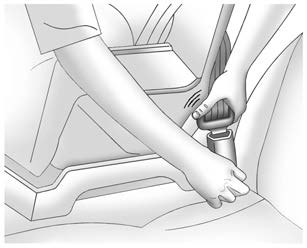
- Push the latch plate into the buckle until it clicks.
Position the release button on the buckle, away from the child restraint, so that the seat belt could be quickly unbuckled if necessary.
There must not be direct contact of the child restraint to the push button.
- Pull the shoulder belt all the way out of the retractor to set the lock. When the retractor lock is set, the belt can be tightened but not pulled out of the retractor.

- To tighten the belt, push down on the child restraint, pull the shoulder portion of the belt to tighten the lap portion of the belt, and feed the shoulder belt back into the retractor. When installing a forward-facing child restraint, it may be helpful to use your knee to push down on the child restraint as you tighten the belt.
Try to pull the belt out of the retractor to make sure the retractor is locked.
If the retractor is not locked, repeat Steps 4 and 5. - If the child restraint has a top tether, follow the child restraint manufacturer’s instructions regarding the use of the top tether. See Lower Anchors and Tethers for Children (LATCH System) page 71.
- Before placing a child in the child restraint, make sure it is securely held in place. To check, grasp the child restraint at the seat belt path and attempt to move it side to side and back and forth. When the child restraint is properly installed, there should be no more than 2.5 cm (1 in) of movement.
To remove the child restraint, unbuckle the vehicle seat belt and let it return to the stowed position. If the top tether is attached to a top tether anchor, disconnect it.
If the head restraint was removed, reinstall it before the seating position is used. See “Head Restraint Removal and Reinstallation” under Lower Anchors and Tethers for Children (LATCH System) 0 71 for additional information on installing the head restraint properly.
Securing Child Restraints (With the Seat Belt in the Front Seat)
This vehicle has airbags. A rear seat is a safer place to secure a forward-facing child restraint. See Where to Put the Restraint page 70.
In addition, the vehicle has a passenger sensing system which is designed to turn off the front outboard passenger frontal airbag under certain conditions. See Passenger Sensing System page 60.
Passenger Airbag Status Indicator page 106 for more information, including important safety information.
Never put a rear-facing child seat in the front. This is because the risk to the rear-facing child is so great, if the airbag deploys.
Warning
A child in a rear-facing child restraint can be seriously injured or killed if the front outboard passenger frontal airbag inflates. This is because the back of the rear-facing child restraint would be very close to the inflating airbag. A child in a forward-facing child restraint can be seriously injured or killed if the front outboard passenger frontal airbag inflates and the passenger seat is in a forward position.
Even if the passenger sensing system has turned off the front outboard passenger frontal airbag, no system is fail-safe. No one can guarantee that an airbag will not deploy under some unusual circumstance, even though it is turned off.
Secure rear-facing child restraints in a rear seat, even if the airbag is off. If you secure a forward-facing child restraint in the front outboard passenger seat, always move the seat as far back as it will go. It is better to secure the child restraint in a rear seat.
See Passenger Sensing System page 60 for additional information.
If the child restraint uses a top tether, see Lower Anchors and Tethers for Children (LATCH System) page 71 for top tether anchor locations.
Do not secure a child seat in a position without a top tether anchor if a national or local law requires that the top tether be anchored, or if the instructions that come with the child restraint say that the top tether must be anchored.
In Canada, the law requires that forward-facing child restraints have a top tether, and that the tether be attached.
When using the lap-shoulder belt to secure the child restraint in this position, follow the instructions that came with the child restraint and the following instructions
- Move the seat as far back as it will go before securing the forward-facing child restraint. Move the seat upward or the seatback to an upright position, if needed, to get a tight installation of the child restraint. There must be finger clearance between the push button and the child restraint.
When the passenger sensing system has turned off the front outboard passenger frontal airbag, the OFF indicator on the passenger airbag status indicator should light and stay lit when you start the vehicle. See Passenger Airbag Status Indicator page 106. - Put the child restraint on the seat.
- Pick up the latch plate and run the lap and shoulder portions of the vehicle seat belt through or around the restraint. Ensure the seat belt webbing is routed as direct as possible and is not caught on seat handles or plastic trim. The child restraint instructions will show you how.
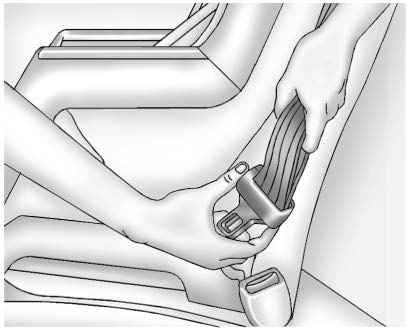 Tilt the latch plate to adjust the belt if needed.
Tilt the latch plate to adjust the belt if needed.
- Push the latch plate into the buckle until it clicks.
Position the release button on the buckle, away from the child restraint, so that the seat belt could be quickly unbuckled if necessary.
- Pull the shoulder belt all the way out of the retractor to set the lock. When the retractor lock is set, the belt can be tightened but not pulled out of the retractor.
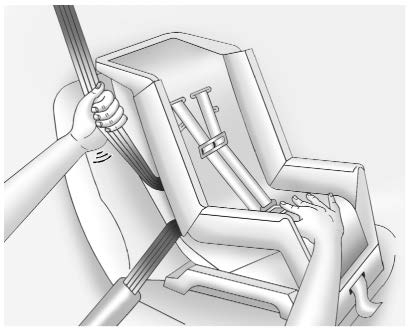
- To tighten the belt, push down on the child restraint, pull the shoulder portion of the belt to tighten the lap portion of the belt, and feed the shoulder belt back into the retractor. When installing a forward-facing child restraint, it may be helpful to use your knee to push down on the child restraint as you tighten the belt.
Try to pull the belt out of the retractor to make sure the retractor is locked.
If the retractor is not locked, repeat Steps 5 and 6. - Before placing a child in the child restraint, make sure it is securely held in place. To check, grasp the child restraint at the seat belt path and attempt to move it side to side and back and forth. When the child restraint is properly installed, there should be no more than 2.5 cm (1 in) of movement.
If the airbag is off, the OFF indicator in the passenger airbag status indicator will come on and stay on when the vehicle is started.
If a child restraint has been installed and the ON indicator is lit, see “If the On Indicator Is Lit for a Child Restraint” under Passenger Sensing System page 60.
To remove the child restraint, unbuckle the vehicle seat belt and let it return to the stowed position.
FAQ
The 2022 Buick Enclave is a midsize SUV that typically seats seven passengers in its standard configuration.
If you choose the available second-row captain’s chairs, the seating capacity is reduced to six passengers.
Yes, the Buick Enclave is known for its comfortable and spacious seats, making it suitable for long-distance drives.
Yes, the driver’s seat is typically adjustable, offering various power adjustments to customize comfort.
Yes, heated and ventilated seats are usually available in higher trim levels or as optional features.
Yes, the 2022 Buick Enclave typically comes with a third-row seat to accommodate additional passengers.
Yes, the third-row seats are usually designed to be folded down to expand the cargo area when needed.
The Buick Enclave often offers a range of seat upholstery options, including leather and premium cloth materials.
Yes, the Buick Enclave typically offers an available rear-seat entertainment system to keep passengers entertained during journeys.
Yes, the 2022 Buick Enclave typically comes equipped with LATCH anchors for securing child safety seats.
Yes, a rearview camera is typically included to assist with parking and enhance safety.
Yes, the Buick Enclave typically features multiple airbags, including front, side-impact, and side curtain airbags, to provide comprehensive protection.
Yes, many safety features are integrated into the Buick Enclave, including seatbelt reminders, airbag deployment systems, and more, to enhance occupant safety.
Yes, the Buick Enclave’s seats are often designed to be versatile and easily configurable to meet various cargo and passenger requirements.
You can find more detailed information about the seats, restraints, and safety features of the 2022 Buick Enclave in the owner’s manual and through safety rating organizations like the National Highway Traffic Safety Administration (NHTSA) and the Insurance Institute for Highway Safety (IIHS). Additionally, Buick’s official website and dealership resources can provide specific details about available features and configurations.
Useful Link
View Full Manual: Buick Enclave 2022 User Manual| Auto User Guide
Buick Enclave 2022 Infotainment System User Manual

